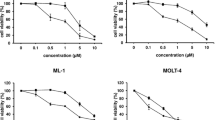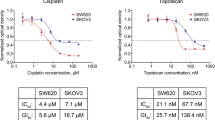Abstract
Purpose: The purpose of this study was to characterize the concentration-dependent induction of apoptosis by anticancer drugs in vitro. Methods: The apoptosis- and necrosis-inducing potential of the anticancer drugs cladribine (CDA), cytarabine (ARA-C), cisplatin (CDDP), and 5-fluorouracil (5FU) were studied in vitro in the human leukemia cell lines HSB2 and Jurkat using a flow-cytometry assay that permits the simultaneous quantification of vital, apoptotic, and necrotic cells by double-staining with fluorescein isothiocyanate (FITC)-labeled Annexin-V and propidium iodide. The results were fit to different multicompartmental models and the sensitivity of the cell lines to apoptosis and necrosis was estimated. Results: A time- and dose-dependent decrease in vital cells as well as an increase in apoptotic and necrotic cells was observed in HSB2 cells upon continuous incubation with 10−5–10−7 M CDA, 10−5–10−8 M ARA-C, 5 × 10−5–5 × 10−6 M CDDP, and 10−4–10−5 M 5FU, whereas no effect was observed relative to controls upon incubation with 10−8–10−9 M CDA, 10−9 M ARA-C, 10−7–10−8 M CDDP, or 10−6–10−9 M 5FU. In Jurkat cells, apoptosis- and necrosis-inducing effects were observed at 10−4–5 × 10−6 M CDA, 10−5–10−7 M ARA-C, 5 × 10−5–5 × 10−6 M CDDP, and 10−4–10−5 M 5FU. In all experiments, apoptotic cells reached a peak after 6–48 h of drug exposure. These data were best fit by a model in which vital cells became irreversibly apoptotic by a direct pathway and necrotic by an irreversible indirect pathway following the apoptotic state (mean R=0.9876; range 0.9510–0.9993; mean modified Akaike's information criterion 3.88; range 1.86–5.82) and the rate constants of either pathway (Kva and Kan, respectively) were assessed. The sensitivity of both cell lines to apoptosis and necrosis (expressed as EC50 and Emax values) induced by the anticancer drugs could be calculated from the sigmoidal concentration-effect curves. Furthermore, it was shown that drug treatment (10−6 M CDA or 10−6 M ARA-C) potentiated the apoptosis-inducing effects of irradiation (6 Gy) but not its necrosis-inducing potential. Conclusion: This study demonstrates that CDA, ARA-C, CDDP, and 5FU possess concentration-dependent apoptosis-inducing potential in the cell lines studied. The cytotoxic mechanism and cell-killing potential of these drugs is different, which is reflected by different EC50 and Emax values. Furthermore, a method for pharmacodynamic modeling is introduced that permits a quantitative approach for the assessment of the sensitivity of tumor cells to anticancer drugs and combined treatments.
Similar content being viewed by others
Author information
Authors and Affiliations
Additional information
Received: 13 July 1997 / Accepted: 5 November 1997
Rights and permissions
About this article
Cite this article
Guchelaar, HJ., Vermes, I., Koopmans, R. et al. Apoptosis- and necrosis-inducing potential of cladribine, cytarabine, cisplatin, and 5-fluorouracil in vitro: a quantitative pharmacodynamic model. Cancer Chemother Pharmacol 42, 77–83 (1998). https://doi.org/10.1007/s002800050788
Issue Date:
DOI: https://doi.org/10.1007/s002800050788




